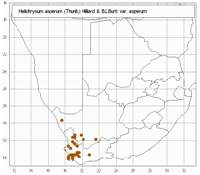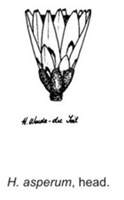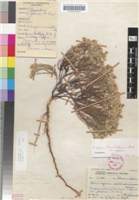Origin of name:
asper / -a / -um = rough
Diagnostic characters:
Small linear leaves
Very small heads
Golden brown bracts
Description:
Hard, stiff, divaricately branched, tangled, bushy shrublet mostly 15�400 mm tall, sometimes straggling, outer spreading branches then sending up numerous erect shoots, branches thinly grey-woolly, often glabrescent, rarely glandular-hispid, leafy. Leaves 2�6 x 0,5 mm (old primary leaves up to 20 x 1 mm), linear, acute to subacute, or obtuse, often apiculate, sessile, margins strongly revolute, both surfaces thinly white woolly-felted, often glabrescent, sometimes glandular-hispid as well. Heads homogamous, c. 4 x 2 mm, cylindric, solitary or 2�4, very rarely more, together at the branch tips, closely surrounded by leaves. Involucral bracts in 5�6 series, outermost short, webbed with wool to surrounding leaves, inner subequal, equaling flowers, erect, tips semipellucid, subacute, often erose, light golden-brown, often reddish below, not radiating, soon caducous. Receptacle raised, slightly tuberculate. Flowers 7�13. Achenes not seen, ovaries with myxogenic duplex hairs. Pappus bristles many, equaling corolla, scabrid, bases with patent cilia not cohering.
Flowering between October and January.
Distribution:
Grows in fynbos on dry stony mountain slopes or flats, or occasionally in Succulent Karoo (Vanrhynsdorp), between c. 120 and 1 200 m above sea level. Ranges from the Cape Peninsula E. to Touws River and White Hill (Laingsburg distr.) and N. to Vanrhynsdorp and Calvinia.
Fynbos, Succulent Karoo and Nama Karoo Biomes.
Notes:
Five varieties are recognized. Not all specimens can be assigned to a variety. Putative hybrids have been reported.
la Heads mostly solitary or 2�4 at the branch tips, rarely more:
2a Tips of involucral bracts light golden-brown, often tinged red, semi-pellucid
(a) var. asperum
2b Tips of involucral bracts opaque white
(b) var. albidulum
1b Heads several at the branch tips:
3a Leaves 2�5 (�10) x 0,5 mm, glabrous
(d) var. glabrum
3b Leaves either variously woolly at least when young, or if glabrous, then leaves mostly 7�10 x 1�1,5 mm:
4a Leaves mostly 7�20 x 1�1,5 mm, woolly or glabrous; tips of involucral bracts white
(e) var. comosum
4b Leaves mostly 3�6 x 0,5�1 mm:
5a Leaves loosely woolly; involucral bracts semipellucid, buff-coloured, sometimes with a reddish tinge
(c) var. appressifolium
5b Leaves enveloped in tightly woven 'tissue-paper' indumentum (though this breaks down to wool with age); tips of involucral bracts opaque white, often reddish above the stereome
(b) var. albidulum
H. asperum var. asperum can be confused with H. oxybelium, which much resembles it in habit, in disposition of the heads, and in colour of the involucral bracts, but var. asperum is easily recognized by its homogamous heads containing 7�13 flowers, not heterogamous and containing 19�29 flowers.
In the type specimen, which is unlocalized, only the young leaves are loosely woolly; the older leaves are merely glandular-hispid. Modern collections from the Cedarberg and from the mountains near Groot Kloof, De Doorns and Worcester tend to be glandular-hispid; elsewhere prominent glands are lacking but both glandular and eglandular plants may grow together.
Taxonomy:
Literature:
Helichrysum asperum (Thunb.) Hilliard & Burtt var. asperum, Hilliard & Burtt in Notes R. Bot. Gdn Edinb. 34: 79 (1975); Hilliard, Compositae in Natal 208 (1977).
Type:
Cape of Good Hope, Thunberg (sheet 20961, UPS, holo.).
Synonym(s):
Stoebe aspera Thunb., Prodr. 170 (1800), Fl. Cap. 728 (1823). Seriphium asperum (Thunb.) Pers., Syn. Pl. 2: 501 (1807).
Gnaphalium ericoides L., Pl. Afr. Rar. 19 (1760), Sp. Pl. 2: 1193 (1763), Amoen, Acad. 6: 99 (1764), non Helichrysum ericoides (Lam.) Pers. (1805). Evax ericoides (L.) Schrank in Denkschr. K. Akad. Wiss. M�nch. 8: 172 (1824). Helichrysum ericoides (L.) D. Don in Sweet, Hort. Brit. 293 (1830), non (Lam.) Pers. (1805). H. ericifolium Less., Syn. Comp. 314 (1832); DC., Prodr. 6: 172 (1838); Harv. in F.C. 3: 217 (1865) excl. var. metalasioides; Moeser in Bot. Jb. 44: 298 (1910) excl. vars.; Levyns in Adamson & Salter, Fl. Cape Penins. 781 (1950). Lectotype: from the Cape of Good Hope (LINN 989.17).
Helichrysum laxum DC., Prodr. 6: 171 (1838). Gnaphalium laxum (DC.) Sch. Bip. in Bot. Ztg 3: 169 (1845). Helichrysum ericifolium var. laxum (DC.) Harv. in F.C. 3: 217 (1865). Lectotype: Western Cape, Paarlberg, Dr�ge 1788 (G-DC; BM; E; S; SAM; TCD; isolecto).
Vouchers:
Acocks 15107 (PRE); Esterhuysen 14964 (BOL; PRE); Galpin 11103 (PRE); Pilans 5411 (NBG).



